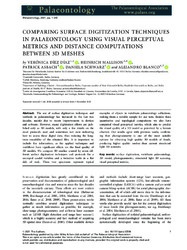Comparing surface digitization techniques in palaeontology using visual perceptual metrics and distance computations between 3D meshes
DOI: https://doi.org/10.1111/pala.12518
Persistent URL: http://resolver.sub.uni-goettingen.de/purl?gldocs-11858/8425
Persistent URL: http://resolver.sub.uni-goettingen.de/purl?gldocs-11858/8425
Díez Díaz, Verónica; Mallison, Heinrich; Asbach, Patrick; Schwarz, Daniela; Blanco, Alejandro, 2021: Comparing surface digitization techniques in palaeontology using visual perceptual metrics and distance computations between 3D meshes. In: Palaeontology, DOI: 10.1111/pala.12518.
 |
Dokument öffnen: |
The use of surface digitization techniques and methods in palaeontology has increased in the last two decades, mainly due to recent improvements in devices and software. However, many digitization efforts are published only as 3D models, with only a few details on the exact protocols used and sometimes not even indicating how to access these digital data, thus reducing the long‐term reusability of the obtained files. It is important to include this information, as the applied techniques and workflows have significant effects on the final quality of 3D models. We compare 3D meshes created by seven different surface digitization techniques and protocols for a sauropod caudal vertebra and a testudine turtle in a flat slab of rock. These two specimens represent typical examples of objects in vertebrate palaeontology collections, making them a suitable sample for our tests. Besides these quantitative and topological comparisons we also have computed visual perceptual metrics, which aim to predict the visual quality of a 3D model as perceived by a human observer. Our results agree with previous works, confirming that photogrammetry is one of the most suitable options for obtaining high quality 3D models of fossils, producing higher quality meshes than current structured light 3D scanners.
Statistik:
ZugriffsstatistikSammlung:
Schlagworte:
surface digitizationvertebrate palaeontology
3D model
photogrammetry
structured light 3D scanning
visual perceptual metrics
This is an open access article under the terms of the Creative Commons Attribution‐NonCommercial License, which permits use, distribution and reproduction in any medium, provided the original work is properly cited and is not used for commercial purposes.

